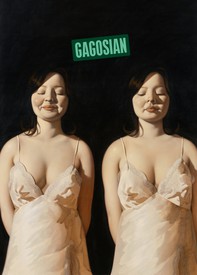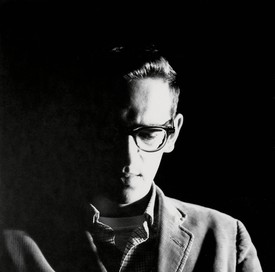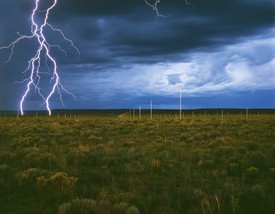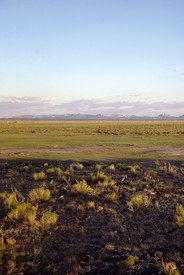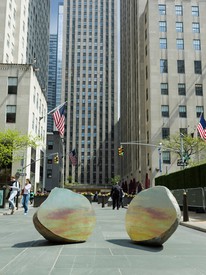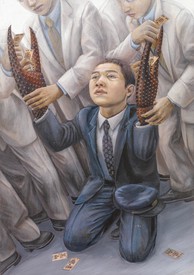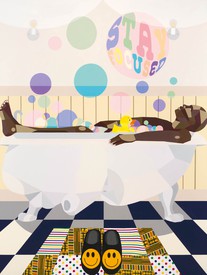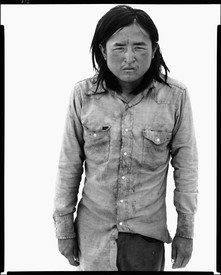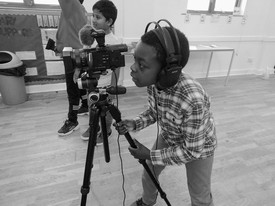Walter De Maria:
RELIGIOUS, SENSITIVE, GOOD
WARM, LOVING, HELPFUL
PROFESSIONAL, ELEGANT, INTELLIGENT
DASHING, FLASHY, WITTY
POSSESSED, ENERGETIC, CRAZY
MOODY, MYSTICAL, MINIMAL
These are Walter’s own words.
He used them at one time to describe his art dealers—
I’m using them now to describe Walter himself.
And I’m speaking here tonight because of my involvement with
The Lightning Field.
I was a member of the installation crew.
One of five New Yorkers—
(Walter himself, of course, Helen Winkler,
Robert Fosdick, and Duane Zaloudek)
Who, along with a remarkable team of local citizens,
School kids, and ranch hands, spent a productive time
In western New Mexico constructing The Lightning Field.
Robert Weathers, was also a member of that original group
And has stayed on these past 40 years as
The Field’s constant and reliable guardian.
For all its metrics, ideals, and precision engineering
The Lightning Field is also the product
Of manual labor and practical know how.
And also, of course, the financial support of Dia.
Everyone involved was working together to realize
Walter De Maria’s ‘MOODY MYSTICAL MINIMAL’ vision.
Walter’s brand of minimalism somehow embraced
The energy and scale of the universe at large.
I’m not joking.
The totality of earth and sky is engaged—
Including the six sacred directions
Of the nearby Zuni and Navajo.
A complete metaphysical landscape is activated.
For Walter, the invisible was real,
A virtual sculptural force actualized.
And he was able to deliver that unseen power
Both metaphorically and physically.
It isn’t an exaggeration
To say that Walter’s work is awe-inspiring.
And thought-provoking—
It pushes all the right ontological buttons.
One story—
When construction on The Lightning Field was completed
Walter offered Robert Fosdick and myself a bonus—
An all-expenses paid trip to Las Vegas, Nevada.
For Walter, the invisible was real, A virtual sculptural force actualized. And he was able to deliver that unseen power Both metaphorically and physically.
Terry Winters
Plus, he wanted to show us the sights—
Including his nearby sculpture Las Vegas Piece.
Walter made us an offer we couldn’t refuse.
So, the three of us flew to Vegas, rented a maroon Chrysler
Cordova at the airport, and immediately drove out
Into a remote valley north of Lake Mead.
The Overton Motel was our base of operations for
The next few days. Walter knew the guy who ran the place.
And our first order of business was to see Las Vegas Piece.
Some years before, Walter had used a bulldozer to cut a few
Shallow lines into the desert floor.
The sculpture was now overgrown and somewhat difficult to find.
But we did eventually track it down, cleared some brush
And walked the entire three miles of the sculpture—
A simple geometric figure whose form can only be discovered
At ground level. Envisioned, over time.
Double Negative was our next destination.
Walter admired Heizer’s work and they were friends.
Both were from California, and both had a connection to
That Western landscape, to that space.
The deep cuts of Double Negative
Were a perfect counterpoint to the lightness of Walter’s drawing.
Each piece equally radical and wildly ambitious—
Icons of Land Art.
Our tour then continued with a visit
To the astonishing Hoover Dam,
Before pressing on to Las Vegas itself.
Caesar’s Palace was to be our first stop.
The Vegas arrival proved difficult.
We didn’t have a reservation and
Evidently didn’t fit Caesar’s demographic,
Or somehow seemed suspicious.
In any case, we were turned away.
They didn’t want our business.
I can still remember the animated argument
Between Walter and the hotel manager.
It was a blessing in disguise.
We headed over to the Sands Hotel
Where Walter promptly booked three executive suites.
A very cool move, and a much better situation. In every way.
After finding the rooms and dropping our bags,
We toured the Casino, had a few drinks,
And caught the late show in The Copa Room.
Dinner and Dionne Warwick.
Total perfection.
The three of us sat beside the stage
Listening to the authentic voice of a great popular artist.
Walter’s own pop music aspirations
Were put aside when he left The Primitives,
The band he formed with Tony Conrad,
John Cale, and Lou Reed.
That group would later become The Velvet Underground.
Walter never looked back but
Once a drummer, always a drummer,
And a percussive sensibility informs all of his work.
Walter kept the beat. The beatitude—
That rhythm and pulse of ancient mystery
Found deep inside the contemporary imagination.
Walter De Maria:
MUSICAL, MAGICAL, MEMORABLE
Artwork © The Estate of Walter De Maria. Text © Terry Winters Studio



